Posts Tagged: 4-H
A Super Bowl of Chili: 4-H'ers prepare 4-alarm chili
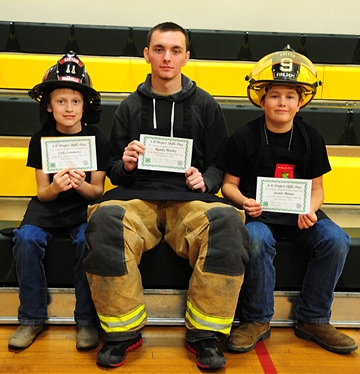
Making a "super bowl" of chili is also quite timely for Super Bowl Sunday on Feb. 2, when the Denver Broncos try to defeather the Seattle Seahawks.
The Solano County 4-H Program traditionally hosts a chili cookoff at its annual Project Skills Day. All clubs in the county are invited to participate.
This year three boys enrolled in an outdoor cooking project teamed to win the four-way competition, held Jan. 11 at C. A. Jacobs School, Dixon.
Cody Ceremony, Randy Marley and Justin Means, all members of the newly formed Pleasants Valley 4-H Club in Vacaville made “4-Alarm Chili,” obtaining the recipe from Justin's uncle, Chuck Means, engineer with the Sacramento Metropolitan Fire District and a co-community leader of the Dixon Ridge 4-H Club. The boys dressed in firefighter uniforms including helmets and turnouts that Means provided.
The outdoor cooking project is a joint endeavor of the Pleasants Valley and Dixon Ridge clubs.
“We simmered the chili for four hours,” Marley said of the recipe which included both pork and beef, plus four types of peppers: pasilla, serrano, anaheim and green bell.
They said it has "a little kick at the end," but not too much. The "heat" can be adjusted, depending on taste.
Judges scored the teams on temperature (it had to be 140 degrees or more), aroma, flavor, texture and freshness, plus a written recipe (neatness), and the overall presentation (table decor and costumes).
Julie Tanaka, a community leader of the Maine Prairie 4-H Club, Dixon, coordinated the event. Judges were Solano County Supervisor John Vasquez Jr. of Vacaville, Ed Coffelt of the Maine Prairie 4-H Club, and longtime 4-H'er Kathy Keatley Garvey of UC Davis/Vacaville.
"The 4-Alarm Chili was very flavorful, and the team understood the combination of ingredients - the blend of the peppers and the blend of the meats," Vasquez said.
"They all put a lot of work into it," the trio of judges agreed.
Also competing were:
- Want Quackers With Your Chili? Vaca Valley: Makenzie Davi, Marissa Davi and Emma Ryder
- Jeans ‘n Beans, Pleasants Valley: Sabrina Brown, Melanie Campilongo, Lillian Tudbury and David Witzel
- The Persim-Monsters, Suisun Valley: Alexis Taliafero, Clairese Wright and Robert Wright
The Quackers' key ingredient was - guess what! - "duck," purchased at a local market. The Persim-Monsters added persimmons to their chili, while the Jeans ‘n Beans team entered a more traditional chili.
Here's the winning recipe:
4-Alarm Chili
2 pounds of pork shoulder, cut in 1/2-inch chunks
2 pounds ground beef
Olive oil (as needed to brown meat)
2 cans of tomatoes (chopped or diced work best)
2 cans of beans (one kidney and one pinto), drained
2 pasilla peppers
2 serrano peppers
2 Anaheim peppers
2 green bell peppers
2 onions
2 cloves garlic
Water (approximately one cup)
Cornstarch
Seasonings to taste:
Beef bouillon, chili powder, ground cumin, garlic salt and black pepper.
Preparation:
In a large stock pot, brown pork in the olive oil. Add the ground beef and continue cooking over high heat until beef is browned (about 30 minutes). Add the water and seasonings. Cook an additional 30 minutes. Add tomatoes and beans. Turn down heat and simmer for 30 minutes. While mixture is simmering, coarsely chop onions and peppers and finely chop garlic. Add these to the pot and continue cooking until pork is tender (about another 30 to 35 minutes). Check flavor and add seasonings to taste. If needed, thicken chili with cornstarch.
This recipe, featuring ground duck, got high marks from the judges.
Quackers' Chili
2 to 3 pounds ground duck (the 4-H'ers purchased duck at a local supermarket; beef can be substituted)
1 to 2 large onions, chopped
6 cloves garlic, chopped
1 tablespoon dried ground cumin, or to taste
1 tablespoon dried oregano, or to taste
1 tablespoon each of chili powder and cayenne pepper (fresh chile peppers may be substituted)
Coarse salt and fresh ground black pepper, to taste
3 to 4 cups of a combination of tomato puree, tomato sauce and fresh/diced tomatoes
2-1/2 cans (14.5 ounces) of beef broth, red wine, or water can be substituted for some of the liquid (Additional broth, wine or water can be used, as needed)
1 to 2 tablespoons molasses (This helps cut down the acidity of the tomatoes. Honey may also be substituted)
1 can each of black beans and kidney beans, rinsed and drained
Condiments:
Grated cheddar cheese
Sour cream
Chopped green onions
Preparation:
in a large pot over medium-high heat, sauté ground duck, onion and garlic until meat is browned. Add cumin, oregano, chili powder, cayenne pepper, salt and pepper, tomatoes and beef broth. Reduce heat to low and simmer, covered, approximately 3 to 4 hours, stirring often. Additional broth, water or red wine may be added as needed.
Add molasses to taste. Add beans and continue to simmer another 30 minutes. Adjust seasonings to taste.
For maximum flavor, cool chili and refrigerate overnight so flavors will mellow. Chili is best made one day ahead to allow the flavors time to meld.
When ready to serve, skim top of solidified fat, reheat over low heat, and serve with cheese sour cream and green onions.
Solano County 4-H Program
Solano County has a total of 500 members in its 12 clubs. Of the seven cities in the county, Dixon has the most, with five clubs.
The clubs are:
Dixon: Dixon Ridge, Maine Prairie, Roving Clovers, Tremont, and Wolfskill
Fairfield-Suisun: Suisun Valley and Westwind
Rio Vista: Rio Vista 4-H Club
Vacaville: Elmira, Vaca Valley, and Pleasants Valley
Vallejo: Sherwood Forest
More information about the Solano County 4-H program is available from Valerie Williams, Solano County 4-H program representative, Solano County Cooperative Extension, at (707) 784-1319 or vawilliams@ucanr.edu. The website is http://cesolano.ucdavis.edu.
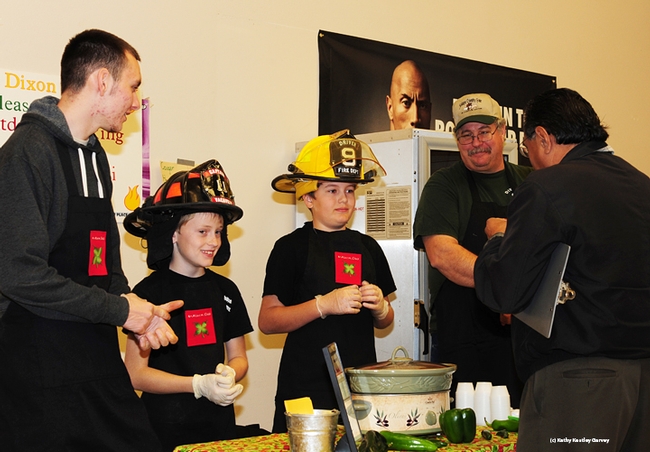
The 4-Alarm Chili Team of the Dixon Ridge 4-H Club and the newly formed Pleasants Valley 4-H Club, watches as judge John Vasquez Jr. samples their dish. From left are Randy Marley, “captain” Cody Ceremony and “driver” Justin Means. In back (at right) is Justin’s uncle, Chuck Means, who provided the recipe and the firefighter uniforms. Chuck Means is an engineer with Sacramento Metropolitan Fire District and a co-community leader of the Dixon Ridge 4-H Club. (Photo by Kathy Keatley Garvey)
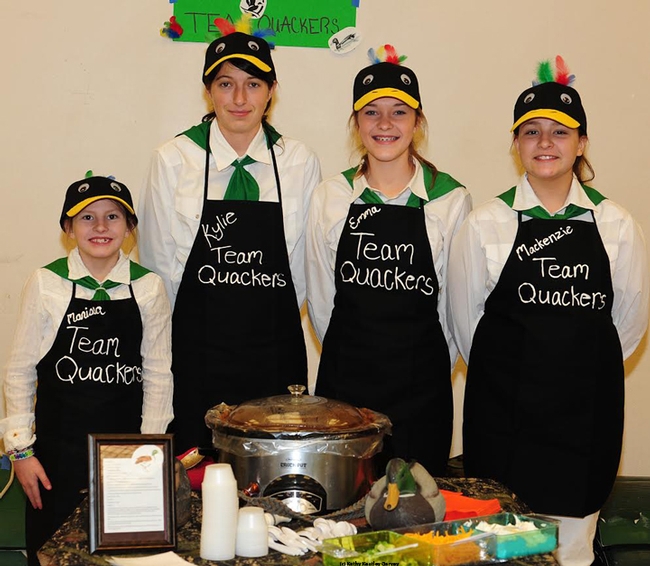
Waiting for judges at the Solano County 4-H Chili Cookoff are Team Quackers (from left) Marissa Davi, Kylie Walker, Emma Ryder and Makenzie Davi, all of the Vaca Valley 4-H Club, Vacaville. Judges praised their chili, which featured duck. For the occasion, they crafted duck hats. They were among four teams competing. The winner: the 4-Alarm Chili, the work of Cody Ceremony, Randy Marley and Justin Means of Dixon Ridge 4-H Club/Pleasants Valley 4-H Club.
4-H Million Trees draws close to the halfway point
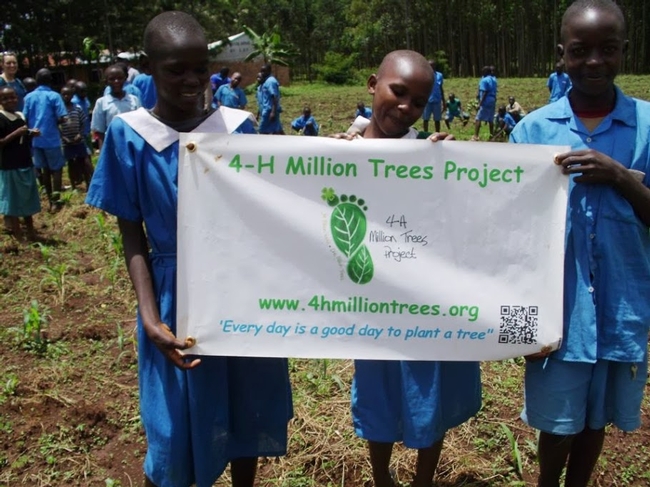
At Huddart State Park, the new trees will help reforest an empty glade that used to be a vollyball court.
"It's a service learning project which is something in 4-H that combines learning with community service," said one of the 4-H team leaders. Fiona Benjamin and Emma Filar are the teen leaders.
The teen leaders involved the Woodside High School Green Academy in the tree-planting event.
"It's good for the environment. It gives us more oxygen to breath," said Karen Estrada, a Green Academy member.
4-H Million Tree planting events have been organized all over the world, including Tanzania, Uganda and Kenya.
"One thing I've taken away from the project is that one person can make an amazing, tremendous difference by getting other people to go along with his or her idea," said the teen leader interviewed in the video.
Richard Enfield wraps up “dream career” as 4-H advisor
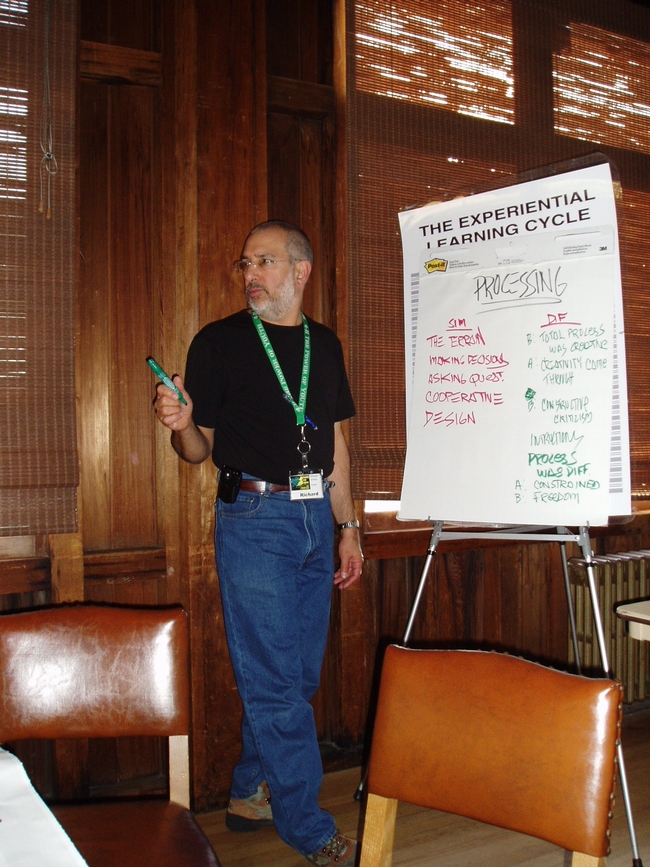
While growing up in urban Irvington, New Jersey, neighbor to Newark, Enfield hadn’t considered a career in agriculture. Community gardening and community supported agriculture experience piqued his interest after he moved to Santa Barbara so Enfield enrolled in the UC Santa Cruz Farm and Garden Project, which was a 12-month apprenticeship program. While studying at UC Santa Cruz, he was introduced to UC Cooperative Extension. He stayed on another year working as a field assistant to the director Stephen Kaffka, who is now a UC Cooperative Extension specialist in the Department of Plant Sciences at UC Davis.
“I became very interested in teaching methods and experiential education and learning,” Enfield said.
Enfield began studying agricultural sciences at Cal Poly San Luis Obispo and joined UC Cooperative Extension as a summer intern in the UCCE 4-H office in San Luis Obispo County after earning his B.S. degree in June 1980. Three months later, he was hired as a 4-H youth development advisor. Under his leadership, the 4-H youth development activities evolved to incorporate more research-based approaches to foster a commitment to learning, positive identity, social competency and positive values.
“Over the years, Richard made the 4-H program more visible in San Luis Obispo County by reaching out and offering the program to not just the traditional club audiences but to other youth,” said JoAnn Overbey, who has volunteered with 4-H for 42 years.
“I remember years ago when 4-H was set up in housing projects in the North County,” Overbey said. “He started the 4-H SLO Scientists Program that youth could join, and this program was years ahead of the UC SET (Science, Engineering and Technology) Program that started a few years ago.”
Enfield designed 4-H SLO Scientists in 1996 to engage families in the hands-on science activities because research shows that direct parental involvement is an important influence on student achievement. More than 1,500 people have participated in the program. In 2011, the program was recognized as one of 4-H’s 15 promising science programs in urban communities across the country.
“SLO Scientists today is still one of our most popular groups to join,” said Overbey, who works for San Luis Obispo County Department of Social Services as a program review specialist for foster care and adoptions. “It can be started in the smaller communities and we reach youth who would not otherwise know about or join a traditional 4-H Club.”
In 1987, Enfield earned an M.A. in educational psychology and research methods from UC Riverside. In 1991 he was appointed UCCE director for San Luis Obispo County, serving for two years. In 2005, he was reappointed UCCE director for San Luis Obispo County and added oversight in Santa Barbara County in 2008, leading UCCE in both counties until his retirement. He also served as interim UCCE director for Ventura County from April 1, 2011, until Aug. 31, 2012.
“Richard was always there with high expectations for performance coupled with personal support and caring,” said Mary Bianchi, a UC Cooperative Extension advisor who reported to Enfield and succeeded him as UCCE director for San Luis Obispo and Santa Barbara counties.
In 2010, Enfield began serving as a 4-H advisor for Santa Barbara County in addition to San Luis Obispo County.
Locally he created a middle-management structure to strengthen the 4-H program. The middle-management structure empowers adult volunteers and teen leaders and allows them to serve in critical 4-H management and program development roles at their peak levels of performance. UCCE offices in other counties have recently begun adopting his model. He also presented the middle management approach at state and national conferences.
“Through his local impacts and national efforts, Richard can rest assured that he has been important in the lives of thousands of children and generations within families,” Bianchi said.
“I can tell you with complete honesty that we would not have the huge steady increase in enrollment without his leadership and skills guiding us,” Overbey said. “He went after all types of available grants that allowed our program to extend beyond just the club level – grants that allowed our youth to be involved in things like oak tree plantings and a 4-H hiking program.”
Enfield has won numerous accolades over his career. In 2005, the San Luis Obispo County Board of Supervisors issued a proclamation recognizing his 25 years of service to children, youth and families in the county. In 2010, his professional peers honored him with the Meritorious Award from the National Association of Extension 4-H Agents. For his work behind the scenes at the statewide administrative level, colleagues acknowledged Enfield with the UC Agriculture and Natural Resources Distinguished Service Award for Leadership in 2011. In February, the Board of Directors of the California Mid-State Fair presented Enfield with a Resolution in Appreciation of Service for “outstanding contributions to the California Mid-State Fair.”
“I loved the freedom to be creative and I enjoyed getting to know all the wonderful and diverse people whom I got to work with and collaborate with on issues of positive youth development and community development,” Enfield said. “Every day was different, exciting and I always felt I was contributing to my community.”
Enfield has been active in the community as well, serving as a member of the Child Abuse Prevention Council of San Luis Obispo County, the Bakari Project Advisory Board at Cal Poly and the SLO Children’s Services Network and participating in the San Luis Obispo County Community Foundation “Pathways to Adulthood” Initiative.
Enfield and his wife Elaine Cormier, a retired optometrist, plan to stay in San Luis Obispo and spend more time hiking, ocean kayaking and bicycling to explore the natural beauty of the area.
“I plan to remain active in the community through various organizations, such as the Asset Development Network of San Luis Obispo County,” Enfield said. “The Asset Development Network is a collaboration of agencies, organizations, and individuals who have come together in order to promote positive youth development throughout the county.
He will also pursue his personal passions of attending ballet performances and baseball games and collecting publications about the West.
“I will continue adding to and developing my collection of over 1,300 modern first editions, dozens of broadsides, and ephemera exploring the American West,” said the East Coast native, explaining that broadsides are beautiful single page prints of book excerpts or poems. “My extensive collection explores the old West to the new West and what it means to be Western and live and work in the West. The collection of fiction, associated nonfiction, and poetry both perpetuates and dispels the myths of the West and explores the sense of place that is so prominent in the literature of the West.”
UC has granted Enfield the prestigious emeritus status so he will continue working on his state and national research projects on the development of individual and community social capital through the 4-H program.
4-H'ers take part in state field day in Davis
More than 1,000 4-H members from around California converged at Wellman Hall east lawn at UC Davis last week to share a wide variety of their leadership, small animal, plant science and other projects at the state field day, reported Tim Hearden in Capital Press.
The event was open to all 4-H members, volunteers, staff and parents. Among the events were a film festival, mock job interview competition, a photography contest and a chess tournament.
The field day began with opening ceremonies, as members from each of the more than 30 counties carried banners.
The event came as California 4-H is celebrating its centennial this year, Hearden reported. In 1913, the forerunner of 4-H was founded as an agricultural club at the college of agriculture in Davis, according to the state website. By the following year, 84 high school agricultural clubs were reported in California.
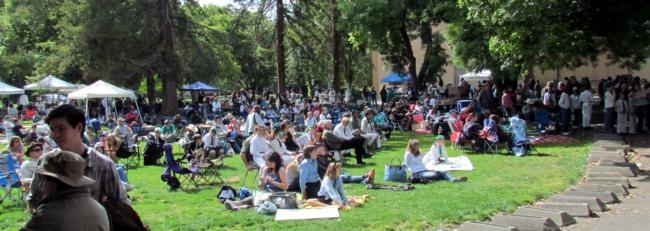
4-H'ers enjoy a picnic-like atmosphere at the annual state field day.
Santa Barbara 4-H feeling budget pressure
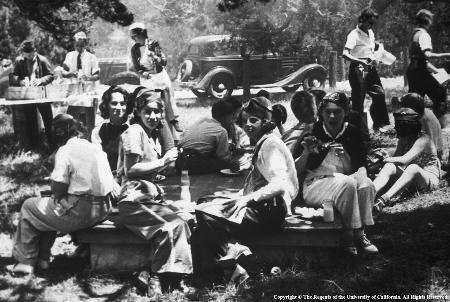
According to the Independent article, written by Mary Thieleke Jackson, director of the Santa Barbara County 4-H Management Board, a draft budget released Friday, May 10, does not include a county contribution to UC Cooperative Extension. Budget hearings are expected to take place the week of June 10-15.
Because the county faces a $10.5 million budget deficit, the board of supervisors is considering all options. If the proposed cut carries through to the final budget, 4-H will cease to exist in Santa Barbara County, the stories said.
"We have to set priorities and figure out what programs work and what programs don't," said Fifth District Supervisor Steve Lavagnino.
He says the board has to make up the budget losses somewhere and he hopes it doesn't include cutting funding for 4-H.
"I can't think of a better place to spend it than on our kids and teaching them about leadership and hard work," said Lavagnino.